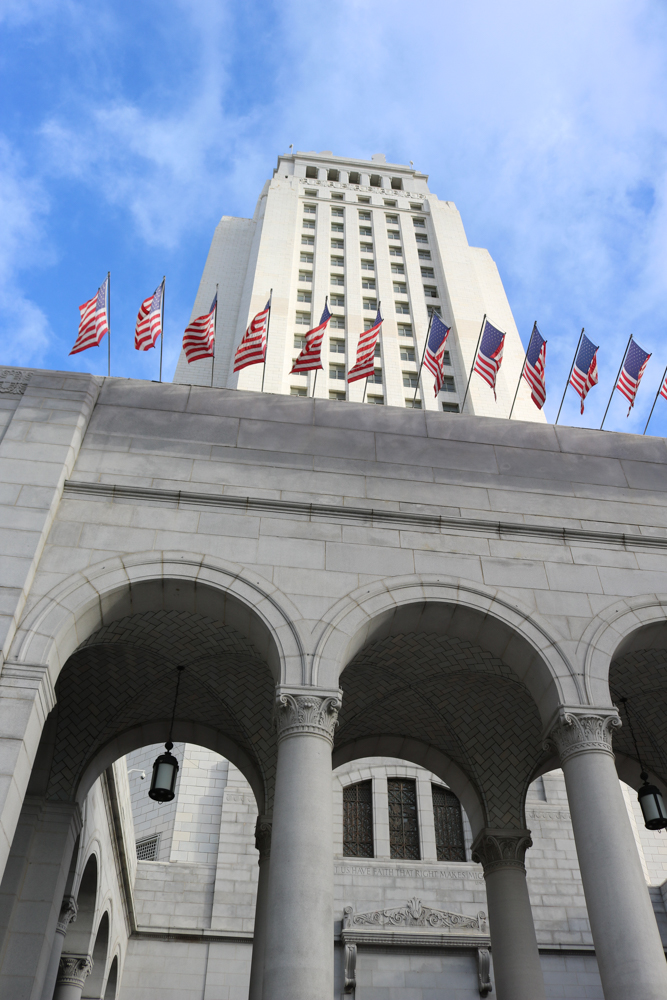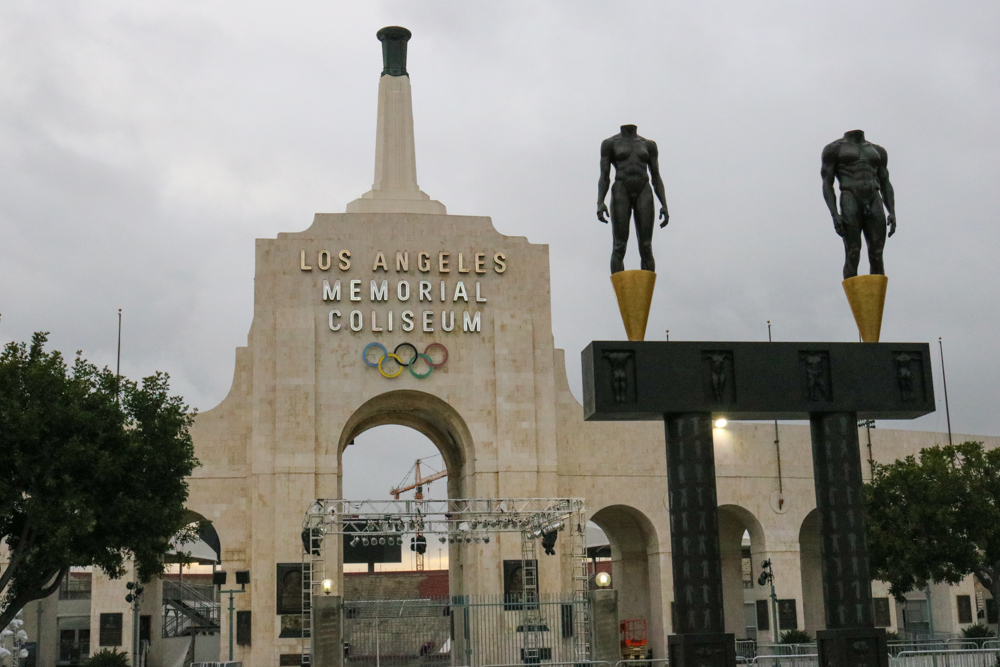
Christopher Hawthorne does not need a crystal ball to see the future of Los Angeles. As a professor in Occidental College’s Urban and Environmental Policy (UEP) department, chief design officer for the city of Los Angeles and former architecture critic for the Los Angeles Times, Hawthorne displays a profound knowledge of the character and future of Los Angeles. In class, he teaches about the urban design and architectural history of Los Angeles, while as chief design officer he puts his expertise into practice, overseeing the city’s major civic architectural projects.
Appointed as the city’s first chief design officer in May 2018 by Los Angeles Mayor Eric Garcetti, Hawthorne came at a pivotal time for Los Angeles. Set to host the Olympic Games in 2028 and facing mounting issues raised by climate change, homelessness and public infrastructure, the city faces a critical moment of transition.
In a 2018 press release, Garcetti stressed the importance of the new position.
“We are investing billions in new infrastructure and public spaces that will transform how Angelenos and people from around the world experience our city,” Garcetti said. “Anyone who’s familiar with Christopher’s work knows that his creative eye and his understanding of urban design are unparalleled. I am proud to welcome him to my administration in this important new role.”

According to Hawthorne, his responsibilities include collaborating with various city departments on city projects, advocating for sustainable and pragmatic architectural practices and improving the public discourse regarding architecture itself.
“We have not in recent decades been known in Los Angeles for the ambition or quality of our civic architecture, and we also have not had a lot of platforms for talking about the future of the city and the kind of city that we as citizens want to have,” Hawthorne said. “There’s probably no city that needs that kind of conversation more at the moment than Los Angeles.”
For both Hawthorne and Garcetti, part of that conversation includes increasing public engagement in city-wide projects.
“The mayor has expressed that he wants public engagement to be a significant part of the work that I’m doing,” Hawthorne said.
Hawthorne emphasized that the success of the city’s future hinges upon improving the discourse regarding architecture and urban design.
“We’re trying to build a comprehensive public transit network, we’re trying to solve a homelessness and housing affordability crisis, we’re trying to imagine what this 21st century Los Angeles will look like and there are a lot of major decisions that we have to confront, and there needs to be … a stronger, more nuanced conversation about how we reach consensus on those issues,” Hawthorne said. “Ultimately, we need to start a conversation about how we balance these tradeoffs.”
According to professor Kelema Moses of the art history department, Hawthorne’s experience and knowledge as a critic and professor position him well to facilitate improved discussions on civic architecture.
“I think that what Christopher Hawthorne does is excellent … public scholarship,” Moses said. “He’s making architecture accessible to large swathes of the community, he’s thinking about issues of housing in addition to thinking about the Olympics and things like that. I think that what he does really reaches a wide audience, and that’s really important when we’re thinking about urban growth, urban development and urban change in LA.”
Moses, who specializes in the architecture and urban design of the South Pacific, believes Hawthorne will apply his critical skills to great effect.
“It’s a unique position, but it’s one that expands upon the discourse. It’s one that gets us to think beyond being an architectural historian, being an architectural critic, being an architect,” Moses said. “It sort of inserts the built environment or the language of the built environment and directly ties it to politics, directly ties it to the political realm, as opposed to being two separate entities operating on their own — architecture and then policymaking. He’s really weaving the two together.”
Former Senior Editor for the LA Times and professor in the Writing & Rhetoric department at Occidental Robert Sipchen agreed.
“[Hiring Hawthorne] was a bold move by Garcetti,” Sipchen said. “But [he is] exactly who you need there, someone who can look at things like a critical drone hovering over the city and doesn’t need to worry about offending … architects or putting his foot in his mouth.”
According to Sipchen, he and Hawthorne met while working at the LA Times and bonded over their shared interests in the city and urban planning.
In 2014, Hawthorne began teaching at Occidental while simultaneously continuing his work at the LA Times. He initially lectured as a guest for classes taught by Sipchen before teaching his own classes in the art history department and later the UEP department.
Chief among his contributions to the college has been the “3rd LA Project.” Described as a “hybrid course” by Hawthorne, the project is a combination of a class and public seminars taught and organized by Hawthorne. It explores the intersection of urban design and politics in Los Angeles.
“It’s been a remarkable experience working with students to help conceive of those public events and to really play an active role in many of them,” Hawthorne said. “And it has been an experiment over several years in thinking about what shape that course might take.”
The dual role of professor and chief design officer presents a particularly nuanced challenge for which Hawthorne has spent a lifetime preparing. Hawthorne said his interest in architecture and urban design traces back to his upbringing in Berkeley, where his mother helped found an advocacy group to preserve historic spaces in the 1970s.
“I had a sense that from a pretty early age that architecture was a profession and also that architecture was something that cities could value or be threatened or might need protection,” Hawthorne said.
According to Hawthorne, architectural interest and inspiration also stemmed from the house he lived in, designed by the renowned architect Julia Morgan, who also designed Hearst Castle in San Simeon, Ca.
“I think growing up in that house was the beginning of my interest in architecture,” Hawthorne said.
Hawthorne attended Yale University, where he graduated with degrees in both architectural history and political science. Hawthorne mentioned his decision to double major represented his interest in the intersection of architecture, urban design and politics.
“I sort of cobbled together a combination of political philosophy and architectural history and theory,” Hawthorne said. “I was very interested in the ways in which the design of that space from an urban design point-of-view affected its use and reputation as a political space.”
After college, Hawthorne moved across the country to pursue a career in architectural criticism before he became the architecture critic for the LA Times in 2004, a role he would fill for 14 years before ending his tenure in 2018. In those 14 years, Hawthorne wrote extensively on the importance of civic architecture and public space.
Hawthorne suggested his experience as a critic for the Times provides crucial insight into his role as chief design officer. Having covered the architecture of the venues from the Olympic Games in Beijing, Rio de Janeiro and Athens, Hawthorne draws from those sources in order to inform decisions regarding the Games in Los Angeles.
“The first priority is making sure that the investments that the city is making in connection with the Games will continue to serve the residents of the city first,” Hawthorne said. “And be intelligent investments from a long-term urban design perspective, rather than producing a kind of ‘white elephant’ of a venue that may play an important role on television for two weeks but not really play a significant role in the life of the city after the Olympics are done.”

For Hawthorne, the Games represent an opportunity for Los Angeles to improve itself in terms of quality of life and infrastructure. As Los Angeles has hosted the Olympics twice in the past — both in 1932 and 1984 — the venues and precedent already exist for the city to host the Games. Thus, Hawthorne’s planning for 2028 focuses on practical improvement.
“We can think about what kind of city we want to show the world, and I think there’s an emerging consensus that what we’re less interested in showing the world a shiny collection of new architectural landmarks and more interested in showing a city that has really thought carefully about equity, inclusion, designs to address climate change,” Hawthorne said.
While 2028 remains a ways away, Hawthorne noted that the future of civic architecture and urban design in Los Angeles can be observed in areas such as Crenshaw and its Destination Crenshaw project, spearheaded by Council member Marqueece Harris-Dawson. According to Hawthorne, the project — which seeks to modernize public transit in the area while preserving the historic character of Crenshaw — advances the conversation about architecture and urban design in Los Angeles in a meaningful and productive manner.
“One of the ways in which the conversation about urban design has changed in the last decade is that we are really asking designers of public and private projects of significant scale, and transportation planners, to think about the wider consequences of this kind of investment,” Hawthorne said. “It’s important to produce new kinds of urban design that, even as its improving public spaces for constituents, it’s also taking steps to safeguard the cultural heritage of the communities.”
Hawthorne also cited the area around the Southwest Museum of the American Indian in the Mount Washington neighborhood as another space that balances the needs of the public with maintaining the character of the neighborhood. Between the museum, neighborhood and nearby Gold Line train station, the area embodies several of Hawthorne’s interests.
“I was really struck by those spaces, in that border between Mount Washington and Highland Park, and the spaces around that — Southwest Museum, Gold Line station in particular — this combination of really idiosyncratic, historic streets and public spaces, and then a kind of future model for mobility in Los Angeles represented by the Gold Line,” Hawthorne said.
According to Sipchen, Hawthorne’s interest in both the history and future of a space defines Hawthorne’s work in striving for a more sustainable Los Angeles.
“All cities have to wrestle with their identities through architecture more effectively now,” Sipchen said. “Part of that is sustainability in the environmental sense, and part of it is just economic and sociological — people have to learn how to get along together and systems have to work together. I think it’s really important that he’s doing that.”
Sipchen expressed some dismay at Hawthorne leaving his role as an architectural critic, noting that Hawthorne’s move left a void at the LA Times. Nonetheless, he remained optimistic that the present and future look bright for the city with Hawthorne as chief design officer.
“It’s a great moment to be in Los Angeles. Chris has landed a very unusual and what I hope is a very exhilarating role for himself,” Sipchen said.
![]()


































